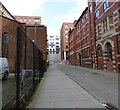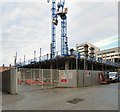1
Blossom Street
Buildings on Blossom Street in Ancoats.
Image: © Peter McDermott
Taken: 28 Sep 2014
0.01 miles
2
Murray Street
In an area of Ancoats that is undergoing restoration. The former church on the right is St Peter's
Image now a permanent rehearsal centre for the Hallé ensembles and a resource for the whole community.
Image: © Gerald England
Taken: 9 Jan 2016
0.02 miles
3
Halle St Peter's
St Peter's Church was built in 1859 to designs by Isaac Holden and was consecrated in 1860. In the late 1950s, the congregation was joined by that of the nearby St James' Church and briefly became known colloquially as St Peter's and Little Jimmies'. Desperately needing repairs but, with a declining congregation, struggling to ever raise enough money for them the church closed shortly after its centenary in 1960.
Twenty-five years of mixed use followed, from University theatre prop storage to a knitting factory. The building was Grade II listed https://historicengland.org.uk/listing/the-list/list-entry/1197806 in 1989 as part of the designation of the Ancoats Conservation Area but in the early 1990s it was abandoned and purchased by a developer with long-term plans to convert it to residential use. The building suffered vandalism and St Peter's was left to rot, a symbol of the wider neglect and dereliction of Ancoats. In 1998 initial work began to restore St. Peter's. By 2003 a major grant had been confirmed from the Heritage Lottery Fund as well as others from English Heritage, the Architectural Heritage Fund and the Northwest Regional Development Agency.
St Peter's Church is now a permanent rehearsal centre for the Hallé ensembles and a resource for the whole community http://www.halle.co.uk/halle-st-peters.aspx The area behind the church between Blossom Street and Hood Street has been preserved as a public open space where events can take place outside.
Image: © Gerald England
Taken: 23 Feb 2018
0.02 miles
4
Hall? St Peter?s
St Peter’s Church, which was consecrated in 1860, was the first Anglican Church to be built in the predominantly Roman Catholic area of Ancoats. As this was a poor area, there was no pew rent and this influenced the choice of brick rather than (the more expensive) stone as the main building material with the innovative use of cast iron columns to support the arches between the nave and the aisles.
The population of Ancoats declined sharply after World War II and the proportion of regular church-goers decreased significantly. In the late 1950s, the congregation was joined by that of the nearby St James’ Church; briefly becoming known colloquially as ‘St Peter’s and Little Jimmies’. The size of the congregation continued to fall becoming unsustainable prior to the church closing in 1960 and being finally abandoned in 1990.
The church had been designated as a Grade II Listed Building in 1974 (Historic England List entry Number: 1197806 https://historicengland.org.uk/listing/the-list/list-entry/1197806 ) and it has been restored as part of the Ancoats Conservation Area. In 2013, the Hallé raised significant funding to complete the restoration and convert it for use as a home for the Hallé’s rehearsals and recordings, its choirs and Youth Orchestra, as well as a space for education workshops and small performances. From the end of March 2018 to late summer 2019, Hallé St Peter’s will be closed for expansion, creating additional rehearsal spaces as well as a café. It is expected to re-open from Autumn 2019.
Image: © David Dixon
Taken: 6 Aug 2018
0.03 miles
5
St Peter's
St Peter's in Ancoats.
Image: © Peter McDermott
Taken: 2 Jan 2015
0.03 miles
6
Hall? St Peter's
St Peter's Church was built in 1859 to designs by Isaac Holden, the founder chairman of the Manchester Society of Architects, who was able to design in a number of continental styles, and the building was consecrated in 1860. Once built the church could seat up to 1,336 people. It was consecrated at 3 pm on Saturday 14th January 1860. A Sunday school opened in 1863.
In the late 1950s, the congregation was joined by that of the nearby St James' Church and briefly became known colloquially as "St Peter's and Little Jimmies'". St. Peter's desperately needed repairs but, with a declining congregation, struggled to ever raise enough money for them. The size of the congregation soon became unsustainable again, however, and the church closed shortly after its centenary in 1960.
Twenty-five years of mixed use followed, from University theatre prop storage to a knitting factory. The building was Grade II listed in 1989 as part of the designation of the Ancoats Conservation Area but in the early 1990s it was abandoned, purchased by a developer with long-term plans to convert it to residential use.
The building suffered vandalism and St Peter's was left to rot, a symbol of the wider neglect and dereliction of Ancoats. In 1998 initial work began to restore St. Peter's. By 2003 a major grant had been confirmed from the Heritage Lottery Fund as well as others from English Heritage, the Architectural Heritage Fund and the Northwest Regional Development Agency.
St Peter's Church is now a permanent rehearsal centre for the Hallé ensembles and a resource for the whole community. This restoration is Phase One of a longer term project to build an extension on the adjoining site to provide workshop, archive and other facilities.
For more details see http://www.halle.co.uk/halle-st-peters.aspx
Image: © Gerald England
Taken: 9 Jan 2016
0.03 miles
7
Hood Street
Image: © Gerald England
Taken: 23 Feb 2018
0.03 miles
8
Smith's Arms
Although earmarked for demolition on more than one plan The Smith's Arms is still standing on Sherratt Street (formerly Spittal Street) in old Ancoats, standing as a defiant relic while old industrial buildings are razed, replaced by the occasional new-build. It was also known as the Blacksmiths Arms and the Hammer in Hand in the 18th century when it was a Taylors Eagle house, then Tetley's and finally a Burtonwood house upon closure at some point in the 1990s. It dates as far back as 1775 when it was built as a three-storey middle class residence, and industrialisation led to its conversion to a public house in 1827.
Information from Pubs of Manchester: http://pubs-of-manchester.blogspot.co.uk/2012/03/smiths-arms-sherratt-steet.html
An archaeological survey done by Manchester University revealed this to be the oldest surviving public house of its type in Ancoats. A link to the survey can be found on the HistoryMe site: https://historyme.wordpress.com/2011/08/15/the-smith-arms-37-sherratt-st-ancoats-manchester-m4/
Image: © Gerald England
Taken: 9 Jan 2016
0.03 miles
9
Smith's Arms
Although earmarked for demolition on more than one plan The Smith's Arms is still standing on Sherratt Street (formerly Spittal Street) in old Ancoats, standing as a defiant relic while old industrial buildings are razed, replaced by the occasional new-build. It was also known as the Blacksmiths Arms and the Hammer in Hand in the 18th century when it was a Taylors Eagle house, then Tetley's and finally a Burtonwood house upon closure at some point in the 1990s. It dates as far back as 1775 when it was built as a three-storey middle class residence, and industrialisation led to its conversion to a public house in 1827.
Information from Pubs of Manchester: http://pubs-of-manchester.blogspot.co.uk/2012/03/smiths-arms-sherratt-steet.html
An archaeological survey done by Manchester University revealed this to be the oldest surviving public house of its type in Ancoats. A link to the survey can be found on the HistoryMe site: https://historyme.wordpress.com/2011/08/15/the-smith-arms-37-sherratt-st-ancoats-manchester-m4/
Image: © Gerald England
Taken: 9 Jan 2016
0.03 miles
10
Construction work on the site of the Smith Arms
Here stood the Smith Arms
Image It hasn't survived. The developers have moved in, demolished it and are now building yet another apartment block on the site.
Image: © Gerald England
Taken: 14 Jan 2017
0.03 miles











